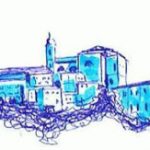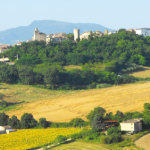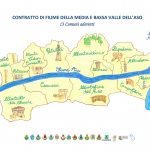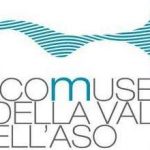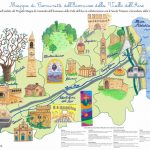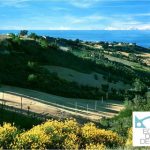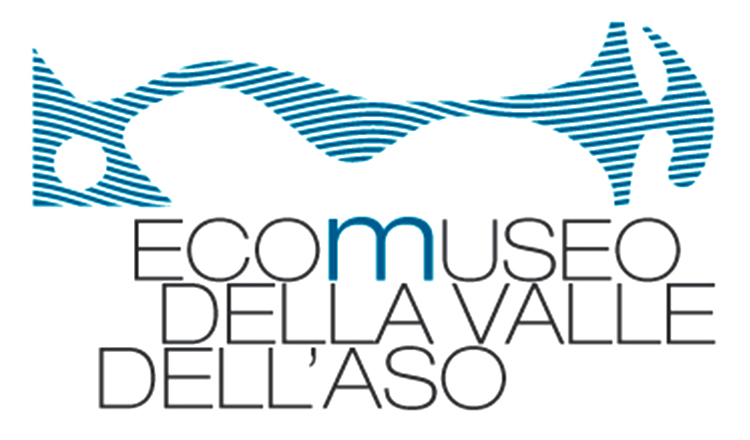
Ecomuseum of Valle of Aso
C.I.T/Valdaso Ecofesta/ The river contract/ Cucina a regola d’arte/Girovallando
C.I.T. – Territorial Interpretation Centres. the establishment of the Territorial Interpretation Centres – C.I.T. – has been implemented through a participatory process and has the purpose of preserving and enhancing the places (whatever cultural, natural, archaeological, architectural), considered by the community to be “significant” of their own cultural identity. It is important to note that both the number of Territorial Interpretation Centres and the contents of the Ecomuseum can be updated and expanded continuously, because the structure of the Ecomuseum is designed as a flexible tool capable of adapting to the needs expressed by the community Pact over time. In the first three years of common work, a considerable effort was made to strengthen the processes of recognition of the material cultural heritage of the Aso valley, through the identification of architectural features and itineraries that alongside notorious and frequented destinations of cultural heritage, include pre-existent, isolated, and less valued places, through an “Open Air Museum” looking glass. In this scenario, 21 centres of territorial interpretation were identified and selected from among those places (museum centres, historic buildings, washhouses, towers, churches, etc.) that were considered by the community – appropriately involved by a participatory approach to recognition – as symbolic and identity-making values. Similarly, the food and wine identities of five products, defined as “identity-making” were identified and promoted. The 21 CITs can be viewed on the interactive map of the Aso Valley.
Valdaso Ecofesta: The Ecomuseum has a coordinating role in the organisation of festivals, events, and exhibitions, trying to steer their effects in order to keep in the territory the positive effects. The project “Valdaso Ecofesta” is part of this context. It is aimed at reducing the production of waste during the manifestations held in the territory. The project outcomes have shown the predisposition to achieve the objectives of sustainable development, recognising to the Ecomuseum a good coordination skill. The use of biodegradable tableware has allowed the reduction in production of mixed waste by approximately 40%, with peaks, in some events, of approximately 70%.
Joint Planning-The river contract: the Ecomuseum stands as an intermediary entity for the implementation of projects aimed at the integrated development of the territory. In particular, it contributed to drafting the Strategic Agenda for the Landscape, which will feed into the new Regional Landscape Plan, and it has also promoted a proposal for a regional law on ecomuseums. The Ecomuseum has also had an active role in the stipulation of the river contract (February 2016), which saw the adoption by the 13 signatory municipalities of a shared set of rules for the protection and management of the Aso river, officially acknowledged as a common good. The rules aim at the improvement of the ecological river quality, and risk prevention, through integrated strategic programming. With these assumptions, and towards the construction of a territorial brand that should be able to connote the Aso valley as an area of quality, and the promotion of sustainable and responsible lifestyles and consumption. The Ecomuseum has been the inventor of the River Contract, of the Agri-food Contract for supporting organic farming, and of the Agri-Environmental Agreement for the protection of waters.
Cucina a regola d’arte nell’Ecomuseo della valle dell’Aso is a brand realised by the company Fabbrica Cultura per l’Ecomuseo della valle dell’Aso (Culture Factory for the Ecomuseum of Aso Valley) that provides three key elements that characterise the territory of the Aso valley: the historical cultural landscape, the widely spread historical and artistic heritage, and a “know-how” of excellence. Its objective is to raise awareness among tourists and residents of the recognition of local products as cultural heritage, and promote the territory for tourism through those products that are a tangible manifestation of the identity of the valley. The project, through meetings dedicated to one or more products, has implemented an integrated promotion of the resources of the territory. The meetings, structured as food and wine festival, were targeting both tourists and the resident community, and various initiatives (show cooking, workshops, tasting workshops, seminars, publications, etc.) were planned. Launched in May 2014, the project is now in its third edition, and it was attended by about 100 partners from public agencies, associations for the promotion of local tourism, trade associations, consortia of companies, individual producers and entrepreneurs, cultural associations, restaurateurs and tour operators. The first edition (May-July 2014) involved the realisation of 4 gastronomic events, dedicated to the Maccheroncini of Campofilone IGP, polenta, sweet wine, ciauscolo, wheat, oil and peach of Valdaso. The first event, La sostenibile leggerezza dei Maccheroncini di Campofilone IGP (The sustainable lightness of Maccheroncini of Campofilone IGP), had as exceptional testimonials the chefs Aurelio Damiani and Moreno Cedroni. The second event, L’Ecomuseo della Valle dell’Aso un giacimento di sapori (The Ecomuseum of Aso valley, a repository of flavours), was dedicated to polenta, ciauscolo and sweet wine. The third appointment, Dieta Mediterranea: acqua e grano della Valdaso (Mediterranean diet: water and wheat of Valdaso) was focused on the potential of the Mediterranean diet, starting from the wheat and oil of the Aso valley. Finally, Licenza di Pèsca (Peach license. Pun based on the similarity between pèsca, peach, and pésca, fishing, in Italian) was dedicated to the peach of the Aso valley, and it saw the participation of Federico Quaranta, journalist of RADIO 2. The second edition (25th April – 3rd May 2015), has repeated the formula of the festival, and was attended by chefs Errico Recanati and Sergio Barzetti. As part of this edition, the food and wine, cultural and scientific events dedicated to the knowledge of the products and companies of the Aso valley were also presented at EXPO 2015. The latest edition (June 2015) saw the collaboration with Gusti&Sapori, a cultural association composed of professionals and entrepreneurs of the food and wine industry of the Aso valley, active in the promotion of the territory. The first phase of the project involved the publication of a special issue of the magazine «Gusti&Sapori», dedicated to the Aso valley, with the intent to promote an area brand, able to present Aso valley as a territory of quality. At a later time, the project included the promotion of the brand Cucina a regola d’Arte abroad. On 27th and 28th June a delegation of the Aso valley participated in the Strawberry Fair of Korycin (Poland), holding a press conference and a seminar on the products at the fair, and organising two show cookings and various business meetings with the regions at the fair.
Girovallando: the Girovallando project, started at the beginning of 2016 thanks to Legambiente Tourism and the participation of about 40 manufacturers and tour operators, acted towards the consolidation of this area brand, through the promotion of the values associated with it. Girovallando is an ecotourism project, which proposed new ways to learn about the Aso valley, with walking routes, cycling or horse riding, that would touch major points of natural and historical-cultural interests and offer support services to the visit, strongly linked to production specificities of the valley. In March 2016, Girovallando was presented in Milan, at Fa la cosa giusta (Do the right thing), a national fair dedicated to critical consumption and sustainable lifestyles, which has represented a fundamental opportunity to promote the Valdaso brand outside the region, by pairing it with the idea of sustainable, responsible, and relational tourism. The topics of sustainable development and tourism were the centre of the second phase of the project, which in May 2016 saw the participation of 40 operators to a sustainable tourism intensive training day, organised by Legambiente Tourism. It is not yet possible to assess the results of the projects in a comprehensive and objective way, since it is still ongoing. However, it represents a further confirmation of the interest of the community and local operators towards the purely ecomuseum issues of participatory land management. From the experiences described and the proposed results, the Ecomuseum, six years after the beginning of the first trials, shows itself as a control room, able to collect and catalyse the stimuli coming from the territory, in the direction of territorial development that has started to produce the first effects. The Aso valley, through the experience of the Ecomuseum, and, in particular, with the projects Cucina a regola d’arte and Girovallando, succeeded in the realisation of a recognisable territorial brand. The brand is able to associate the territory with its distinctive resources and it is progressing towards its consolidation, through the promotion of an integrated tourist offer, for the protection of the environment and landscape, and perfectly oriented to the needs of sustainability.
Information
Name of the Ecomuseum: Ecomuseo della Valle dell’Aso
Geographical location: Italy, Marche region, province of Ascoli Piceno
Year of establishment: 2010
Network: Rete Italiana Ecomusei
Website: www.ecomuseovalledellaso.it

